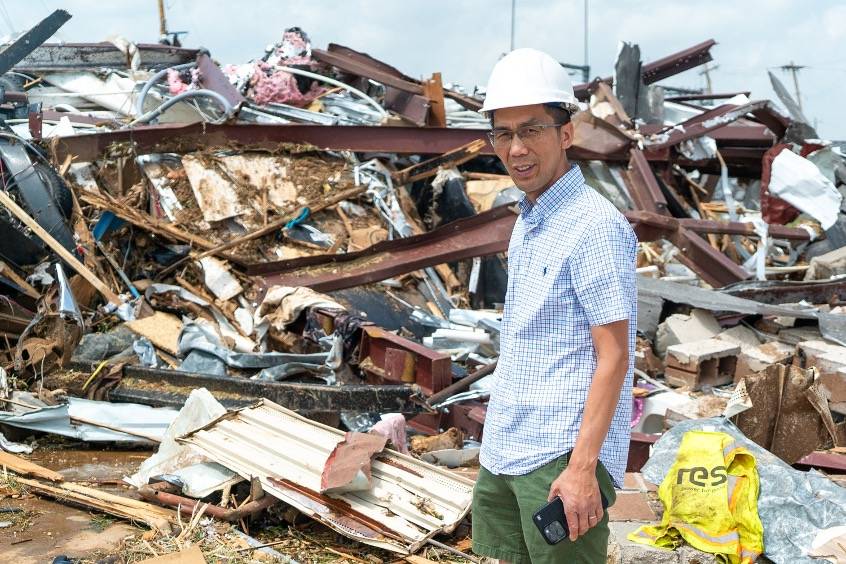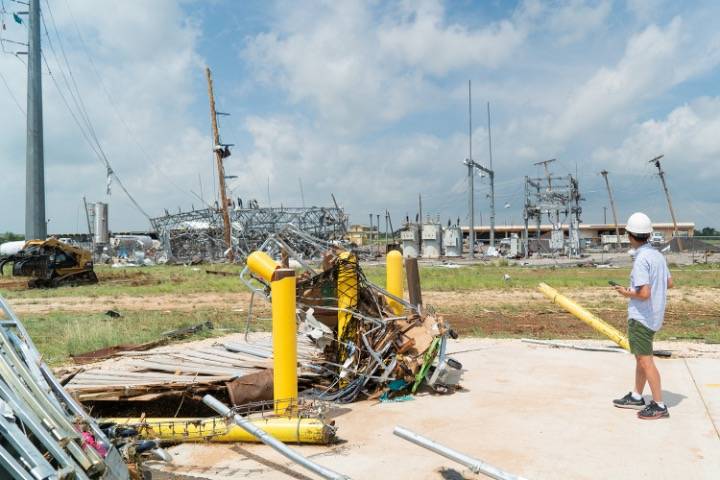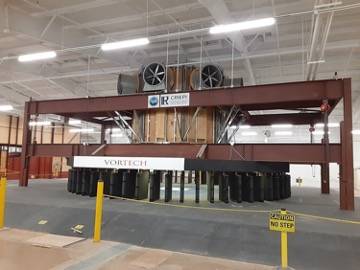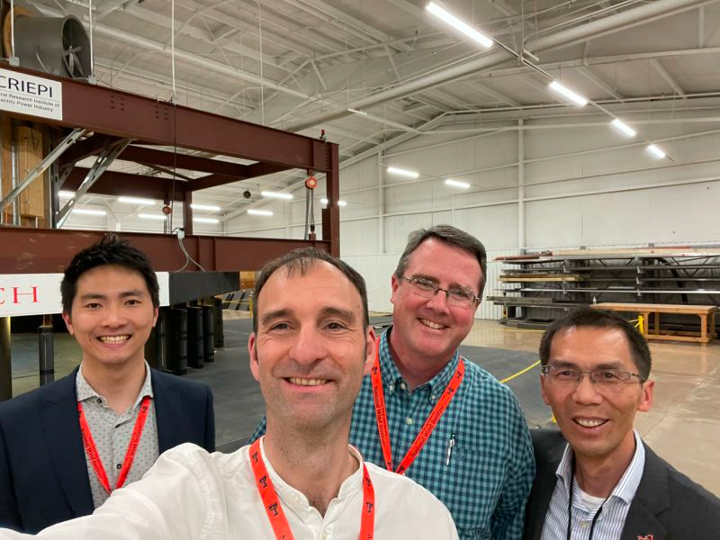Delong Zuo, NWI faculty member and professor in Civil and Wind Engineering, discusses continuing efforts toward a tornado-resilient community.

Dr. Zuo in front of tornado damage, photo courtesy of Texas Tech Today.
Have you ever wondered why one house is more susceptible to wind damage than the next-door neighbor? Or how traffic lights can sway in intense storms without damage? Understanding the impacts of wind on structures, and how we can make structures more wind resistant, is something that drives Dr. Delong Zuo, NWI faculty and Professor in Civil and Wind Engineering.
“Your interests may shift, but the fundamentals stay the same.”
Zuo, and others at NWI, have had a long outstanding drive to understand the impacts of wind on various structures. What started as understanding how bridges in Houston, TX are impacted by wind during his Ph.D., transitioned to the interactions of wind and slender structures. The curiosity of the interaction between wind and structures then inspired him to start investigating tornado related problems.

Zuo looking upon tornado damage from the Matador TX tornado. Photo courtesy of Texas Tech Today.
The problem with tornadoes and structures related research is it is challenging to observe and compare damage from multiple windstorms naturally. For example, two tornadoes may pass over the exact location but may have vastly different outcomes in damage. This problem led to the creation of VorTECH, one of the largest tornado simulators in the world. The simulator has been shown to be able to generate vortices that are similar to tornadoes in many key features.
“We are doing three types of research. Physical simulation, numerical simulation, and probabilistic simulation.”
Projects led by Zuo follow a structure unique to his group. Projects include the observation of a structure failure, the recreation of the failure in a controlled environment, understanding why the failure happened, and finally, the probability that this failure will reoccur.
It has often been observed that structures with large, overhead doors, like fire stations, sustained a particularly high amount of damage during tornadoes. It has been speculated that once an overhead door is damaged, the likelihood of damage to the overall structure was increased. Zuo’s group is investigating this theory by moving small structures with overhead doors through VorTECH. The small structures contain a large number of pressure sensors, so the group can measure and understand changes in pressure on a structure during the passage of a vortex.

VorTECH tornado simulator located at Reese Technology Center.
The data from the controlled simulations is then used to form probabilistic models and numerically simulate loading. This enables the group to study how a building reacts to the different forces caused by the wind.
Understanding the reaction of a building can then be used to predict the future reactions of structures under similar (or different) conditions. Meaning, Zuo’s group can predict the likelihood of damage to a home given different conditions such as wind speed, prior damage, duration of high winds, etc.
“We evaluate the risk of a building subjected to tornadoes. It is not like what other people are doing.”
Previous understanding of why a structure failed was based primarily on what happened after a storm. Now, Zuo’s group can understand a storm’s impact before it happens and is doing this for all different shapes and sizes of buildings. The ability to observe, simulate, and predict the likelihood of damage from tornadoes in one group is a unique contribution to the engineering field in and of itself. Zuo hopes their findings will influence engineers, law makers, and others to prioritize the design of buildings that can withstand these powerful windstorms.
“What we are doing right now has the potential to influence the design of tornado resistant buildings.”
Even though new findings are exciting, working with students is one of his biggest inspirations. During his own graduate school experience, his advisor modeled the importance of endless curiosity, ultimately impacting his own career path. These past experiences then influenced his perception of working with students.
“The most important part of being a professor is getting to work with students. You see them grow with the curiosity to discover new science.”

Zuo (far right) and colleagues in front of VorTECH during the 2014 American Conference of Wind Engineering.
Not only is he positively influencing his students' careers, but the diverse backgrounds of his students and other NWI faculty are continuously influencing him. This past semester, Zuo taught a multi-disciplinary course in wind engineering. Zuo described the class as one of the most challenging classes he has ever taught due to the diverse backgrounds of all the students.
“Sometimes even when you teach the classical [concepts], sometimes students [of different backgrounds] will approach it from another angle.”
This class is just one of many examples of the cross-discipline structure of NWI. The rich history of collaboration between disciplines, whether that be engineering, atmospheric science, social science, or even business, has established NWI as one of the first and most distinguished hazard-mitigating research facilities in the field.
“You can pursue some bigger ideas that, by yourself, you cannot even dream of.”
